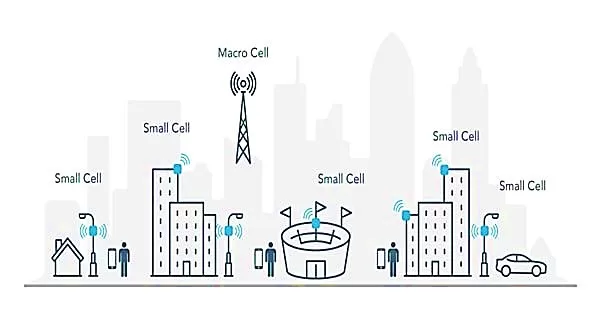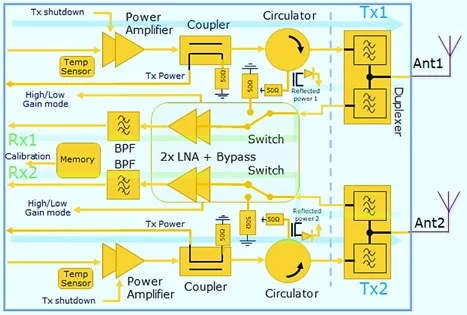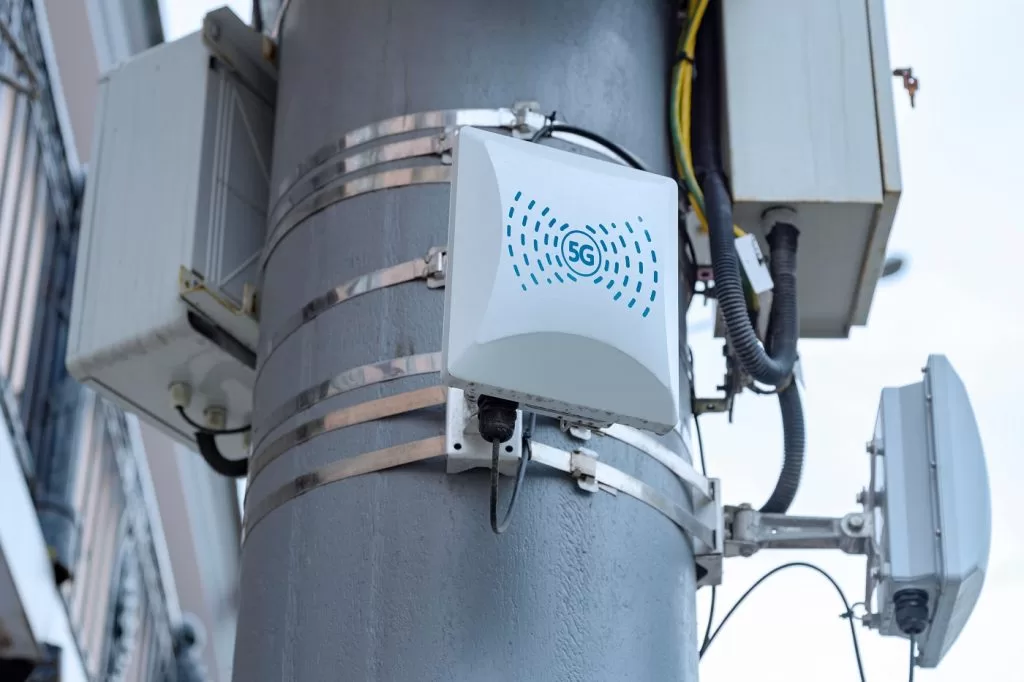Abstract:
The demand for high-speed connectivity and seamless network coverage is on the rise due to the increasing number of connected devices and data-intensive applications. To address this, the fifth generation (5G) cellular network is being deployed worldwide. However, deploying traditional macro cell towers to meet the coverage and capacity requirements of 5G networks may not be enough, especially in urban areas. This is where small cell networks come into play.
This article provides an overview of the 5G small cell network, including its general specifications, deployment scenarios, focusing on the changes brought about by the introduction of 5G technology. The article highlights the diversification of small cell form factors and architectures, driven by a range of use cases and a comparison to 5G NR.
What is a Small Cell Network?

Figure 1: Small Cell Illustration
A small cell is a low-power radio access node used to enhance wireless network coverage and capacity in areas with high user density, such as urban areas, stadiums, airports, and shopping malls. Small cells are typically installed indoors or outdoors, and they are designed to complement the coverage of macrocell base stations, which provide wide-area coverage for cellular networks [1].
Small cells are smaller in size and transmit at lower power levels compared to macrocells, which allows them to reuse the same frequency band as the macrocells without causing interference. Small cells can be deployed using various radio access technologies, such as 4G LTE, 5G, and Wi-Fi, and they can be connected to the core network using wired or wireless backhaul links.
The deployment of small cells can improve network coverage, capacity, and quality of service for wireless users.
Small cells are essential for 5G networks, which require high-frequency bands and low-latency connections. 5G networks rely on a dense network of small cells to provide ultra-fast speeds and low latency to users.
Overall, small cells play a critical role in meeting the increasing demand for wireless communication and supporting emerging use cases such as IoT and smart cities. By deploying small cells, wireless operators can improve network capacity, coverage, and quality of service, leading to better user experiences and increased revenue opportunities.
General Specifications:
5G small cells conform to 3GPP TS38 series specifications, specifically for small cell features [1].
- Release 15 is the first 5G NR release that supports the eMBB service, including NSA and SA operation.
- Release 16 offers additional support for MIMO, beamforming, dual carrier, and carrier aggregation, as well as unlicensed spectrum, industrial IoT, and URLLC service.
- Release 17 provides further enhancements to support eMBB, URLLC, and mMTC services.
- Small cells support two base station classes based on 3GPP [TS38.104]:
- Medium-range base stations, which are adapted from microcell scenarios for Outdoor deployment.
- Local area base stations, which have been developed from picocell scenarios for indoor local area
- Small cells support various frequency bands defined by 3GPP [TS38.104], including FR1 and FR2 bands, which may be licensed, shared, or unlicensed, depending on deployment.
- Small cells are not suitable for mMIMO, with more than 16TX and 16RX co-located RF channels or TRXUs, which are better suited for macrocell configurations.
- Beamforming and hybrid beamforming are particularly relevant to FR2 small cells.
- Small cells support both MU-MIMO and SI-MIMO.
Deployment Scenarios:
| Deployment Scenario | Description | Use Cases |
| Urban | Small cells deployed in densely populated urban areas to enhance network capacity and coverage. | Shopping malls, stadiums, airports, public transportation hubs, city centers. |
| Rural | Small cells deployed in rural areas to provide coverage and capacity where macrocells are not feasible. | Agriculture, mining, oil and gas, transportation. |
| Indoor | Small cells deployed indoors to provide coverage and capacity in buildings, such as offices, hotels, hospitals, and shopping centers. | Office buildings, hotels, hospitals, shopping centers. |
| Dense Urban | Small cells deployed in ultra-dense urban areas, such as city centers and downtown areas, to provide high-capacity and low-latency connections. | Smart cities, autonomous vehicles, augmented and virtual reality, video streaming. |
| Private Networks | Small cells deployed for private networks, such as industrial IoT and critical communications, to provide reliable and secure wireless connectivity. | Industrial IoT, manufacturing, transportation, public safety, healthcare. |
Table 1: Small Cell Deployment Scenarios
High-Level Architecture:
The high-level architecture of a 5G small cell typically includes the following components:
- Radio access network (RAN): The RAN includes the small cell base station, which provides wireless access to user devices via radio signals. The small cell base station communicates with the core network over a high-speed backhaul connection.
- Core network: The core network manages the overall operation of the small cell network, including authentication, authorization, and routing of user traffic. It includes various functions such as the User Plane Function (UPF), Control Plane Function (CPF), and Session Management Function (SMF).
- Transport network: The transport network provides the high-speed connectivity between the small cell base station and the core network. It can be based on various technologies such as fiber optic cables, microwave links, or satellite links.
- User equipment (UE): The user equipment consists of the end-user devices such as smartphones, tablets, laptops, and other IoT devices that connect to the small cell network.
- Management and orchestration: The management and orchestration component is responsible for the provisioning, configuration, and monitoring of the small cell network. It includes various management functions such as fault management, performance management, security management, and network automation.
Overall, the 5G small cell architecture is designed to provide high-speed and low-latency connectivity to users in areas where traditional macrocell networks may not be sufficient, such as in densely populated urban areas or indoor environments. The small cell network can also be used to offload traffic from the macrocell network, improving overall network capacity and performance.
Structure and General Design Small Cell:
Small cell radio units are typically powered by a host network and radiate RF signals using integral or external antennas. They can receive synchronization from the host network, macro network, or GNSS receiver located outdoors. The small cell radio unit can be broken down into several functions, including Interfaces, Baseband, RF transceiver, RF front end (RFFE), and Antennas.
Here is an overview of the components of a small cell architecture with technical details for each:
Interfaces and Power:
- Physical connections for interfacing into a DU or CU.
- Additional optional interfaces for Synchronization and local access.
- Provided with power and a fronthaul/midhaul data connection by a host network.
Baseband (BB):
- Contains the digital electronics required to run 3GPP protocol and physical layer stacks.
- Responsible for time synchronization, security functions, and configuring and monitoring other functions in the small cell.
- Comprises a single chip in the case of a low layer fronthaul split or separate NPU and PHY chips for higher level splits.
- May serve one or more carriers and/or operators, with similar or different radio access technologies.
Network Processing Unit (NPU):
- Terminates fronthaul/midhaul interface.
- Implements Datapath functionality as determined by functional split.
Physical Layer (PHY):
- Implements 3GPP physical layer processing functions.
- Can be split into high-PHY and low-PHY functions.
- High-PHY functions include Scrambling, Channel coding, Modulation, Layer mapping, Equalization, and Forward error correction.
- Low-PHY functions include Precoding, Digital beamforming, Fast Fourier Transform, PRACH filtering, and Digital front end.
- Provides real-time control to the RF front end.
RF Front End (RFFE):
- Incorporates transmit power amplification, receiver low noise amplification, filtering, and duplexing.
Functional block FDD (frequency division duplexing) RFFE block diagram:

Figure 2: Small cell RFFE components in FDD mode [2]
- The dashed line indicates the boundary between the RFFE and two duplexers in the 2T2R configuration.
- The left side of the line is identical to the same portion of TDD mode RFFE except for the connections of the circulators and switch.
- This design approach unifies the RFFE interface with antennas in the two system operations.
- This methodology can reduce the extra effort when the designer wants to change the current design to another or wants to implement a multi-mode small cell to provide TDD and FDD operations in the same hardware.
- One or more RFFE may be populated depending on the number of bands supported.
Antennas:
- Interface between the small cell and the free space.
- Radiates RF power and captures the signal from the user equipment (UE).
Synchronization:
- Small cell baseband must reference local clocks back to a primary reference for accurate synchronization.
- Most deployments for NR will need to be time-aligned to within ≤3us down to ≤65ns, dependent on features supported.
Security:
- Primary concern for anyone deploying a network, including small cell architectures.
- Security functions are implemented in the baseband part of the small cell.
RF Transceiver:
- Implements the digital/analog conversion and translation to RF frequencies.
- For 5G, these are FR1 ‘sub6’ or FR2 mmW.
- One or more RF transceivers may be populated depending on the number of antenna ports and/or RF bands to be supported.
Small cells play a crucial role in the deployment of 5G services, enabling high-speed mobile connectivity in small coverage areas. With the continued evolution of mobile communication technologies, small cells will become more prevalent and will continue to play a critical role in the development of advanced wireless networks.
5G Small Cell vs 5G NR:
The table below compares key features of 5G small cell and 5G NR. The 5G small cell is a low-power radio access node that provides coverage and capacity in densely populated areas. It has a small coverage area and is typically deployed indoors or outdoors in public spaces. The 5G NR, on the other hand, is the global standard for 5G wireless technology and is designed to provide high-speed, low-latency, and reliable connectivity for a wide range of applications [3].
| Feature | 5G Small Cell | 5G NR |
| Purpose | Provides coverage in small areas | Provides coverage in larger areas |
| Power | Low power | High power |
| Form Factor | Small and compact | Large and complex |
| Coverage Area | Up to a few hundred meters | Up to several kilometers |
| Frequency Bands | Typically operates on licensed and unlicensed spectrum | Operates on licensed spectrum |
| Deployment | Indoor and outdoor | Outdoor only |
| Connectivity | Fronthaul/midhaul data connection provided by host network | Dedicated backhaul connection |
| Antennas | Integral or external antennas | External antennas |
| Radio Performance | Provides lower data rates and coverage than 5G NR | Provides higher data rates and coverage |
| Standards | Compliant with 3GPP standards | Compliant with 3GPP standards |
| Cost | Generally cheaper than 5G NR | Generally more expensive than 5G Small Cell |
Table 2: 5G Small Cell vs 5G NR
The comparison table shows that both 5G small cell and 5G NR support high data rates and low latency, but the small cell has a shorter range and lower power consumption. Small cells are typically deployed in clusters to provide coverage and capacity in specific locations, while 5G NR is deployed on a larger scale to provide coverage across wider areas.
Another difference is that small cells support both licensed and unlicensed spectrum, while 5G NR primarily uses licensed spectrum. Small cells are also more flexible and can be deployed in various form factors, including standalone, integrated, and virtualized solutions. In contrast, 5G NR is a standardized technology that is used by multiple operators and vendors and requires specialized equipment and infrastructure.
Conclusion:
In conclusion, a small cell network is a vital component of the 5G infrastructure that enables efficient wireless communication in densely populated areas. With their compact size and advanced features, small cells conform to the 3GPP TS38 series specifications and are designed specifically for small cell deployment scenarios.
The high-level architecture of a 5G small cell includes various components, such as the radio unit, baseband unit, and network interface, all working together to provide seamless connectivity.
While both 5G small cells and 5G NR serve as crucial components of 5G networks, they differ in terms of their deployment scenarios, technical specifications, and capabilities.
In the future, 5G small cells are expected to play an even more significant role in meeting the ever-increasing demand for high-speed wireless data. With the ongoing deployment of 5G networks and the increasing adoption of IoT devices, small cells are likely to become more ubiquitous and form a key part of the wireless infrastructure in dense urban areas, public venues, and indoor environments. Additionally, advancements in technology, such as the development of mmWave small cells, are expected to further enhance the performance of 5G small cell networks, making them more attractive for both service providers and end-users.
References:
- [1] SCF238. 5G small cell architecture and product definitions. July 2020. Document 238.10.01
- [2] SCF251 5G NR FR1 Reference Design. Dec 2021. Document 251.10.01
- [3] Mobility Report, Ericsson, 2020

